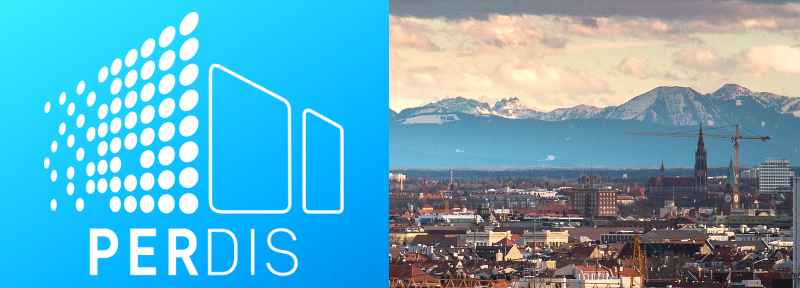

Paper presentation slots are 15 Minutes
|
9:00 |
Registration opens |
|
10:00 - 17:00 |
Tutorials |
|
Tutorial 1: Displays Everywhere: An Introduction to Augmented Reality Tutorial 1 |
|
|
Tutorial 2: Introduction to Augmented Reality and practical examples mobile augmented Reality based on HTML Tutorial 2 |
|
|
Tutorial 3: Foundations of interactive Pervasive Display Systems: Understanding the future of digital signage Tutorial 3 |
|
|
Tutorial 4: Intelligent Interactive Systems – an Introduction to Machine Learning for Human-Computer Interaction Tutorial 4 |
|
|
17:30-19:00 |
Lab Reception including Demos |
|
8:00 |
Registration opens |
|
9:00-9:10 |
Opening |
|
9:10-10:00 |
Keynote: Saturated Display Environments |
|
10:00-10:30 |
Break |
|
10:30-12:30 |
SESSION I: Large Displays and Design Strategies Applying the Cumulative Fatigue Model to Interaction on Large, Multi-Touch Displays Design Strategies for Overcoming Failures on Public Interactive Displays ShapelineGuide -- Teaching Mid-Air Gesture for Large Interactive Displays SlideTalk: Encouraging User Engagement with Slideshow Displays Space is Part of the Product: Using AttrakDiff to Identify Spatial Impact on User Experience with Media Façades Using Pervasive Displays to Aid Student Recall - Reflections on a Campus-Wide Trial |
|
12:30-13:30 |
Lunch |
|
13:30-15:10 |
SESSION II: Display Applications and Interfaces Car Exterior Surface Displays: An in-the-Wild Evaluation Investigating User Preferences for Windshield Displays in Automated Vehicles Exploring Vibrotactile and Peripheral Cues for Spatial Attention Guidance Investigation of an Ambient and Pervasive Smart Wall Calendar with Event Suggestions Vibrotactile Alarm Display for Critical Care |
|
15:10-15:30 |
Poster and Demos Introduction |
|
15:30-17:00 |
Posters/Demo Session and Coffee |
|
from 19:00 |
Social Event: Augustiner am Platzl
|
|
8:00 |
Registration opens |
|
9:00-9:45 |
|
|
9:45-10:15 |
Break & Posters/Demos |
|
10:15-12:15 |
SESSION III: Novel Displays and Installations An 1834 Mediterranean garden in Berlin, engaged from 2004, 2019, 2032, and 2202 FlyMap: Interacting with Maps Projected from a Drone Ice as an Interactive Visualization Material: a Design Space Levitating Particle Displays with Interactive Voxels Plantxel: Towards a Plant-based Controllable Display Welcoming the Orange Collars: Robotics Performance in Daily Life City Environment |
|
12:15-13:30 |
Lunch |
|
13:30-15:10 |
SESSION IV: Augmented Reality, Virtual Reality and Display Awareness Designing Low-Res Lighting Displays as Ambient Gateways to Smart Devices Exploring networked message signs as a new medium for urban communication FlyingARrow: Pointing Towards Out-of-View Objects on Augmented Reality Devices Modeling and Understanding User Behavior around Public Head-Mounted Displays Smart Jewelry: Augmenting Traditional Wearable Self-Expression Displays |
|
15:10-16:00 |
Closing |
As it has become customary for PerDis, we will again offer a two in-depth tutorials on the first day of the symposium. The tutorials will take place on June 6.
Introduction to Augmented Reality and practical examples with the Microsoft HoloLens
Pascal Knierim (LMU Munich, Germany)
The course will start with an introduction to augmented reality basics and concepts (joint with tutorial 2). There will be practical examples and hands on experience of how to create immersive augmented reality application using the Microsoft HoloLens.
Introduction to Augmented Reality and practical examples mobile augmented Reality based on HTML
Jakob Karolus (LMU Munich, Germany), Matthias Hoppe (LMU Munich, Germany)
The course will start with an introduction to augmented reality basics and concepts (joint with tutorial 1). Additionally there will be practical examples of how to create an engaging augmented reality solution using HTML on mobile devices, in particular phones and tablets. Such applications run – without additional apps just in the browser – on most devices currently in the market.
Foundations of interactive Pervasive Display Systems: Understanding the future of digital signage
Prof. Florian Alt (Bundeswehr University Munich, Germany), M.Sc. Mohamed Khamis (LMU Munich, Germany)
The course will introduce the foundation and concepts of pervasive display systems with a focus on user engagement, interaction, and evaluation. Furthermore, the course will include practical exercises on conception, designing, and studying pervasive display systems and feature a session on gaze-based interation with pervasive displays. The course will be based on “Davies, Nigel, Sarah Clinch, and Florian Alt. "Pervasive displays: understanding the future of digital signage." Synthesis Lectures on Mobile and Pervasive Computing 8.1 (2014): 1-128.”
Attendees are strongly encouraged to submit a max. one-page description of their ongoing research in the area of pervasive displays with a particular focus on the main challenges (email to Florian Alt (florian.alt@unibw.de) on or before 3rd June 2018).
Schedule (tentative):
10:00 - 11:30 Welcome & Introduction to pervasive displays
11:30 - 12:00 Coffee Break
12:00 - 13:00 How to evaluate pervasive displays
13:00 - 14:00 Lunch Break
14:00 - 15:30 Practical Exercise
15:30 - 16:00 Coffee Break
16:00 - 17:00 Introduction to Gaze-based interaction with pervasive displays & case studies
Intelligent Interactive Systems – an Introduction to Machine Learning for Human-Computer Interaction
Sven Mayer (University of Stuttgart, Germany), Huy Viet Le (University of Stuttgart, Germany)
In this course, we will provide a hands-on introduction to machine learning for developing intelligent interactive systems. Participants will learn how to develop neural network architectures, train them, and run the trained models. Moreover, they will export the models to deploy them on a mobile device. Participants will use Keras to implement a neural network and experiment with it during the tutorial.
Prof. Nigel Davis
Data Science Institute at Lancaster University, UK
Digital signage and pervasive displays have been the subject of intense research for many years, led in part by the work of the PerDis community. To date, most research has focused on user engagement with sparse display networks in which users interact infrequently with small numbers of displays. However, we are living in a world in which our physical spaces are becoming increasingly enriched with computing technology including pervasive displays. In this talk I will focus on the natural end-point of this trend and consider the case when displays become truly ubiquitous and saturate our physical environments, using as motivation a state-of-the-art display deployment in which mobile users navigating a space are simultaneously exposed to many hundreds of displays within their field of view. Such saturated display environments present an entirely new set of research challenges and opportunities that I will explore, focusing in particular on providing analytics that capture user interaction with these systems.
Nigel Davies is a Distinguished Professor of Computer Science and Co-Director of the Data Science Institute at Lancaster University. He has held visiting positions at Sony Electronics, Google Research, ETH Zurich, CMU and most recently Università della Svizzera italiana. In addition, Nigel has served as CTO for an SME creating novel IoT systems for the highways sector. His work is in the area of pervasive computing including systems support for new forms of data capture and interaction and is characterized by an experimental approach involving large-scale deployments of novel systems with end-users. Nigel has chaired many of the major conferences in the field, is a former editor of IEEE Pervasive Computing and an Associate Editor of IEEE Transactions on Mobile Computing. He was the coordinator for the FET-OPEN PD-NET project that first proposed the idea of open display networks.

Prof. Gudrun Klinker
Technical University Munich, Germany
As new display and tracking technology for virtual and augmented reality is emerging in great strides, it becomes increasingly important to investigate the usability and their user experience in applications. Gaming provides many very good scenarios for testing novel user experiences. Via gamification, these may be brought back into a wide range of applications. This presentation will discuss and analyze opportunities and challenges of providing user experiences for live experimentation in AR and VR settings.
Exploring Vibrotactile and Peripheral Cues for Spatial Attention Guidance
Tim Claudius Stratmann, Andreas Loecken, Uwe Gruenefeld, Wilko Heuten, Susanne Boll
Space is Part of the Product: Using AttrakDiff to Identify Spatial Impact on User Experience with Media Façades
Patrick Tobias Fischer, Saskia Kuliga, Mark Eisenberg, Ibni Amin
Designing Low-Res Lighting Displays as Ambient Gateways to Smart Devices
Marius Hoggenmueller, Alexander Wiethoff, Martin Tomitsch
FlyMap: Interacting with Maps Projected from a Drone
Anke M. Brock, Julia Chatain, Michelle Park, Tommy Fang, Martin Hachet, James A. Landay, Jessica R. Cauchard
Levitating Particle Displays with Interactive Voxels
Euan Freeman, Julie Williamson, Praxitelis Kourtelos, Stephen Brewster
Public HMDs: Modeling and Understanding User Behavior around Public Head-Mounted Displays
Christian Mai, Mohamed Khamis
Car Exterior Surface Displays: Exploration in a Real-World Context
Ashley Colley, Jonna Häkkilä, Meri-Tuulia Forsman, Bastian Pfleging, Florian Alt
FlyingARrow: Pointing Towards Out-of-View Objects on Augmented Reality Devices
Uwe Gruenefeld, Daniel Lange, Lasse Hammer, Susanne Boll, Wilko Heuten
Using Pervasive Displays to Aid Student Recall - Reflections on a Campus-Wide Trial
Mateusz Mikusz, Sarah Clinch, Peter Shaw, Nigel Davies, Petteri Nurmi
SlideTalk: Encouraging User Engagement with Slideshow Displays
Jake Patterson, Sarah Clinch
Exploring networked message signs as a new medium for urban communication
Rui José, André Pinheiro, Helena Rodrigues
Investigating User Preferences for Windshield Displays in Automated Vehicles
Andreas Riegler, Philipp Wintersberger, Andreas Riener, Clemens Holzmann
Vibrotactile Alarm Display for Critical Care
Vanessa Cobus, Bastian Ehrhardt, Susanne Boll, Wilko Heuten
ShapelineGuide – Teaching Mid-Air Gesture for Large Interactive Displays
Florian Alt, Sabrina Geiger, Wolfgang Höhl
Plantxel: Towards a Plant-based Controllable Display
Vito Gentile, Salvatore Sorce, Ivan Elhart, Fabrizio Milazzo
Design Strategies for Overcoming Failures on Public Interactive Displays
Callum Parker, Marius Hoggenmüller, Martin Tomitsch
Applying the Cumulative Fatigue Model to Interaction on Large, Multi-Touch Displays
Zhe Liu, Daniel Vogel, Jim Wallace
Smart Jewelry: Augmenting Traditional Wearable Self-Expression Displays
Ashley Colley, Inka Rantala, Jonna Häkkilä
Investigation of an Ambient and Pervasive Smart Wall Calendar with Event Suggestions
Alexandra Voit, Rufat Rzayev, Dominik Weber, Niels Henze
Welcoming the Orange Collars: Robotic Performance in Everyday City Life
Fatma Ergin, Andre Afonso, Ava Fatah Gen. Schieck
An 1834 Mediterranean garden in Berlin - Engaged from 2004, 2019, 2032, and 2202
Brygg Ullmer, Philip Paar, Liviu Coconu, Jing Lyu, Miriam Konkel, Christian Hege
Ice as an Interactive Visualization Material: a Design Space
Ashley Colley, Antti-Jussi Yliharju, Jonna Häkkilä
Demos can be setup during break and lunch. Thursday between 10:30 - 11:00 and 12:30 - 14:00.
A Smartphone-Based Tangible Interaction Approach for Landscape Visualization
Liviu Coconu, Brygg Ullmer, Philip Paar, Jing Lyu, Miriam Konkel and Hans-Christian Hege
COMB - A Modular Low-Resolution Display to Support Electronic Musical Pre-Education
Beat Rossmy and Alexander Wiethoff
Demo: Vibrotactile Alarm Display for Critical Care
Vanessa Cobus, Bastian Ehrhardt, Susanne Boll and Wilko Heuten
EyeSeeX: Visualization of Out-of-View Objects on Small Field-of-View Augmented and Virtual Reality Devices
Uwe Gruenefeld, Dana Hsiao and Wilko Heuten
An AR-method for documenting LEGO Serious Play models
Jonas Herbert and Thomas Herrmann
Towards Multi-touch Learning Applications in Collaborative Education
Matthias Ehlenz, René Roepke and Ulrik Schroeder
Using Pervasive Displays to Aid Student Recall - Reflections on a Campus-Wide Trial
Mateusz Mikusz, Sarah Clinch, Peter Shaw, Nigel Davies, Petteri Nurmi
A Multi-user Interactive Public Display with Dynamic Layout Optimization
Yoshio Matsuda and Takashi Komuro
On the Suitability of Real-Time Assessment of Programming Proficiency using Gaze Properties
Calvin Liang, Jakob Karolus, Thomas Kosch and Albrecht Schmidt
An AR-method for documenting LEGO Serious Play models
Jonas Herbert and Thomas Herrmann
Ecological Invitation to Engage with Public Displays
Salvatore Sorce, Vito Gentile and Davide Rocchesso
Oz's Fitting Room: Fashion Coordination Support System by Digital Signage and Human-driven Virtual Agent
Masahumi Muta, Yuka Ishikawa, Toshimasa Yamanaka and Soh Masuko
Exploring Usability and Accessibility of Avatar-based Touchless Gestural Interfaces for Autistic People
Salvatore Sorce, Vito Gentile, Debora Oliveto, Rossella Barraco, Alessio Malizia and Antonio Gentile
Snow Wall as an Interactive Display in Urban Environment
Antti-Jussi Yliharju, Taro Mori and Jonna Häkkilä
Proficiency-Aware Systems: Adapting to the User’s Skills and Expertise
Jakob Karolus and Albrecht Schmidt
Towards Multi-touch Learning Applications in Collaborative Education
Matthias Ehlenz, René Roepke and Ulrik Schroeder